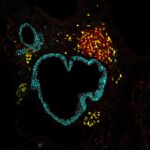
Publication: Blockade of the co-inhibitory molecule PD-1 unleashes ILC2-dependent antitumor immunity in melanoma
Publié dans: Nature Immunology, 2021, 22 (7), pp.851-864. ⟨10.1038/s41590-021-00943-z⟩
Auteurs: Nicolas Jacquelot, Cyril Seillet, Minyu Wang, Angela Pizzolla, Yang Liao, Soroor Hediyeh-Zadeh, Sharon Grisaru-Tal, Cynthia Louis, Qiutong Huang, Jaring Schreuder, Fernando Souza-Fonseca-Guimaraes, Carolyn de Graaf, Kevin Thia, Sean Macdonald, Mary Camilleri, Kylie Luong, Shengbo Zhang, Michael Chopin, Tristan Molden-Hauer, Stephen Nutt, Viktor Umansky, Bogoljub Ciric, Joanna Groom, Paul Foster, Philip Hansbro, Andrew Mckenzie, Daniel Gray, Andreas Behren, Jonathan Cebon, Eric Vivier, Ian Wicks, Joseph Trapani, Ariel Munitz, Melissa Davis, Wei Shi, Paul Neeson, Gabrielle Belz
Résumé
Group 2 innate lymphoid cells (ILC2s) are essential to maintain tissue homeostasis. In cancer, ILC2s can harbor both pro-tumorigenic and anti-tumorigenic functions, but we know little about their underlying mechanisms or whether they could be clinically relevant or targeted to improve patient outcomes. Here, we found that high ILC2 infiltration in human melanoma was associated with a good clinical prognosis. ILC2s are critical producers of the cytokine granulocyte-macrophage colony-stimulating factor, which coordinates the recruitment and activation of eosinophils to enhance antitumor responses. Tumor-infiltrating ILC2s expressed programmed cell death protein-1, which limited their intratumoral accumulation, proliferation and antitumor effector functions. This inhibition could be overcome in vivo by combining interleukin-33-driven ILC2 activation with programmed cell death protein-1 blockade to significantly increase antitumor responses. Together, our results identified ILC2s as a critical immune cell type involved in melanoma immunity and revealed a potential synergistic approach to harness ILC2 function for antitumor immunotherapies.
Lien vers HAL – amu-04831552
Lien vers le DOI – 10.1038/s41590-021-00943-z

